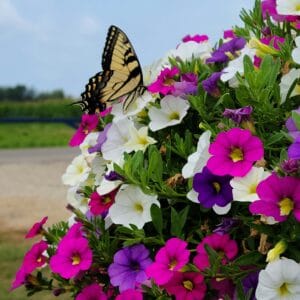
By Jennifer Fairfield, owner Garden Mill
What the heck, Mother Nature?
It is not supposed to be this dry (or hot) in May. My pond is at late-July/early August levels (that is to say, there’s not much water in it right now). I’ve been dragging hoses around to make sure that the trees that I planted in April have enough water (something I don’t usually have to do in May), and even my native plant beds were looking sad, because I don’t generally water them at this time of year.
I had no choice but to give them a good soaking finally – there is no appreciable rain expected in the next two weeks, according to the weather forecasts, just some “chance of showers” sorts of things towards the end of our 10-day forecast. At least the cold stuff seems to have ended. I think. You never know with Michigan weather, do you?
Well, even though it was hot and dry over the holiday weekend, it was a pretty good time for getting things done in the garden and yard. I’m still a little behind, but I’m hoping to remedy that situation this weekend. How about you? Are you all caught up? That’s kind of a joke – you’re never caught up when it comes to gardening.
Here are some things to do in order to stay at least somewhat ahead of the game this month:
In the veggie garden:
The main thing we all need to be doing right now is watering. Everything. Constantly. That may be a slight exaggeration, but only a slight one. With the unusual lack of rain in May and the high temps we’ve been experiencing lately, our plants need our help to supply them with enough water to keep them alive and thriving.
The cold overnight temps that we were having up until just a week ago made it difficult to get warm-weather veggies and herbs planted, so now we need to play catch-up. If you haven’t gotten your veggies and herbs planted yet, now is the time. We have a short growing season, and many of the things we all love to grow – tomatoes, peppers, eggplant, cucumbers, squash, etc. – all need long growing periods to produce a good crop. So, get them in now. And then water them. And water them some more. Still need seedlings? We’ve got lots of plants available at the store for tomatoes, sweet and hot peppers, eggplant, kale, and all sorts of herbs.
Plant seeds of carrots, bush beans, dill, and cilantro every week or two. This way, you can be sure to have a continuous harvest throughout the season. Be sure to read the package information about how long each variety you are planting needs to mature. Figuring that our first frost usually hits around Oct. 15, you can determine how late you can plant things and still hope to get a good harvest. Once you have planted seeds, be sure to keep the soil around them moist. Seeds won’t generally germinate in dry soil.
You can apply a thin layer of mulch to help keep moisture in the soil, but be careful not to put so much mulch over the seeds that the new plant shoots struggle to get through.
For anything that needs support, be sure to get stakes or cages in at the time you plant so that you don’t damage roots later. Be sure to mulch them at the time of planting, too. Mulch does a number of great things for your plants – it keeps the soil temperature consistent, suppresses weeds, helps retain moisture, and helps prevent soil-borne diseases from spreading to your plants.
Spray tomatoes, cucumbers, and squash with an organic fungicide early and often to prevent diseases. Begin as soon as you get the plants in the ground, and follow the manufacturer’s instructions for frequency (usually weekly). Diseases such as blight, powdery mildew, and downy mildew can only be prevented, not cured. Applying fungicide on a weekly basis can help prevent diseases from getting started, as can making sure to space your plants properly. Good airflow through the garden helps things dry out in between rains, which helps keep spores from growing.
Weeding is an important part of keeping your plants healthy and producing, even if it’s not everyone’s favorite chore. Weeds compete for water and nutrients, and they can also be disease carriers. Doing a little weeding every time you’re in the garden can make it seem a little less tedious, and getting weeds before they get too big is so much easier than waiting until they are towering over everything.
It’s especially important to pull weeds before they go to seed, so that they aren’t starting a new generation of weeds in your garden. I had a fun (not really) reminder of this recently. For a variety of reasons, I had not been able to get into some of my flower beds to get them cleaned up this spring. I started on that task a week or so ago and found the bed I was working in was a total mess of weeds.
It started out with my determination to pull the handful of garlic mustard that I saw – before it went to seed – then I saw some purple deadnettle that needed to come out, and then I found something I have never encountered before, and it was all over. When I reached to pull it, it literally spit its seeds at me. I’m not kidding – I got a face full of seeds every time I got near the plants. I looked it up later, and found that it was hairy bittercress, which I had not gotten to before it went to seed, and which has this crazy thing it does to spread its seed effectively.
Whenever something touches it, even a breeze, it throws seeds as much as 3 or more feet away. Because I didn’t get to it before it had formed seeds, I will likely be pulling that stuff for years now. You can bet I won’t let that happen again next year. Here’s a video of the stuff in action, in case you’ve never had the pleasure of having it spit its seeds at you.

June is a time when lots of insects start showing up in gardens. Aphids, flea beetles, cucumber beetles, Colorado potato beetles, cabbage moths, and slugs will be making meals out of your plants this month and into the summer, if left to their own devices. While most healthy, mature plants can withstand some of these, young, tender, new plants can be decimated in no time. The key to keeping them from causing unrecoverable damage is to keep a close eye out for them and get them before there are so many that they overwhelm your plants.
Be sure to identify who is doing the damage before you reach for the insecticide though – the right solution depends on the pest. Also be careful when and how you are applying pesticides. Any pesticide that you use has the potential to kill beneficial insects, such as bees and butterflies, so making sure that you are targeting your application to the affected plants (rather than broadly spraying) and spraying in the evening when bees and butterflies are generally not as active can help prevent unintentionally killing insects that can be helping to keep the bad guys at bay.
Speaking of butterflies, keep in mind that those beautiful creatures start out as what some would call “ugly” caterpillars. Those caterpillars need to eat in order to turn into butterflies, and often, what they are eating is what you have planted in your gardens.
I had a customer in the store ask me how to get rid of the caterpillars that were eating his fennel every year. My answer was that he should just plant more fennel, so there would be enough for both him and those caterpillars, because they turn into beautiful black swallowtail butterflies.
All butterfly caterpillars have a limited number of things they can eat – for black swallowtails, things in the parsley family, which includes parsley, dill, fennel, carrots, celery, cumin, and cilantro are on the menu. I always plant more dill and parsley in my garden than we will ever eat, with the hope of attracting the butterflies to lay their eggs in my garden.
I also like to let some of my herbs go to flower to feed the adults. If you’d like to see more butterflies in your yard, the National Wildlife Federation has a comprehensive list of plants that attract many varieties of butterflies.
(Publisher’s note: Part 2 will publish tomorrow.)










